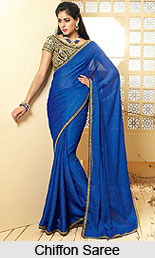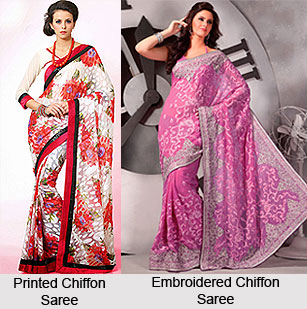 Chiffon is a light gauzy like fabric of silk, nylon, etc and are lightweight and transparent. The material gives an elegant floating appearance to any outfit and especially to the Indian saree. The chiffon sarees are most widely used by the Indian women and today, the chiffon sarees are used as regular wear and are also found in the closet of youngsters. Being so elegant, chiffon sarees are ideal for evening wear.
Chiffon is a light gauzy like fabric of silk, nylon, etc and are lightweight and transparent. The material gives an elegant floating appearance to any outfit and especially to the Indian saree. The chiffon sarees are most widely used by the Indian women and today, the chiffon sarees are used as regular wear and are also found in the closet of youngsters. Being so elegant, chiffon sarees are ideal for evening wear.
Chiffon can be made from silk, nylon or polyester. It is a sheer light-weight fabric which creates an elegant look which is suited to both light and heavier embroidery. Chiffon sarees are also considered as party sarees that have a perfect blend of elegance and style. These are available in vibrant colour with contrasted designs and are widely used in Indian fashion sarees.
Types of Work in Chiffon Sarees
Chiffon is smoother and more lustrous than the similar fabric georgette. Only a discerning eye may be able to tell the difference between the three fabrics i.e. chiffon, crêpe and georgette. This kind of saree is usually heavily embellished. The embellishments may be in pure gold and silver, as also Swarovski crystals which enhance the beauty of the material. These are commonly referred to as designer sarees. Chiffon sarees often incorporate Bandhani printing which depicts ancient regional Indian designs. Including this, the fashion designers create distinct looking pieces of sarees by reintroducing the traditional motifs like hand-block printing, zardousi and embroidery work in chiffon sarees.

Process of Designing Chiffon Sarees
The chiffon sarees are made with very fine, tightly twisted yarns that could be either in the filling or the warp or both. When sewing chiffon, many crafters layer tissue paper in between the two pieces being sewn together. The tissue paper helps keep the fabric together, with the rough surface of the tissue holding the chiffon in place while it is handled. After sewing, the tissue paper can be carefully ripped out.
Under a magnifying glass it resembles a fine net or mesh which gives chiffon some see-through properties. Chiffon can be dyed to almost any shade, but chiffon made from polyester can be difficult to dye. As a general rule, sewers are advised to work slowly and steadily with this fabric, taking care not to run it through a sewing machine too quickly lest it bunch and gather.
The chiffon sarees have a flimsy look that has made the saree most sought after among the women. The Indian artisans, who are settled in different parts of the country, have started incorporating different modern designs, sometimes blending traditional with contemporary designs to make the chiffon sarees further attractive. Moreover, the present trend allows incorporating "Zardousi" work in the chiffon sarees with heavy bead work, sequin work, zari work, mirror work etc. Sometimes these chiffon sarees are created keeping in mind certain themes by the famed designers and are worn in marriages and other occasions. Focusing on the trend, bridal wear sarees are also created using chiffon as base material.
It is also a popular fabric used in blouses, ribbons, scarves and lingerie. Like other crepe fabrics, chiffon can be difficult to work with because of its light and slippery texture. Due to this delicate nature, chiffon must be hand washed very gently.





















